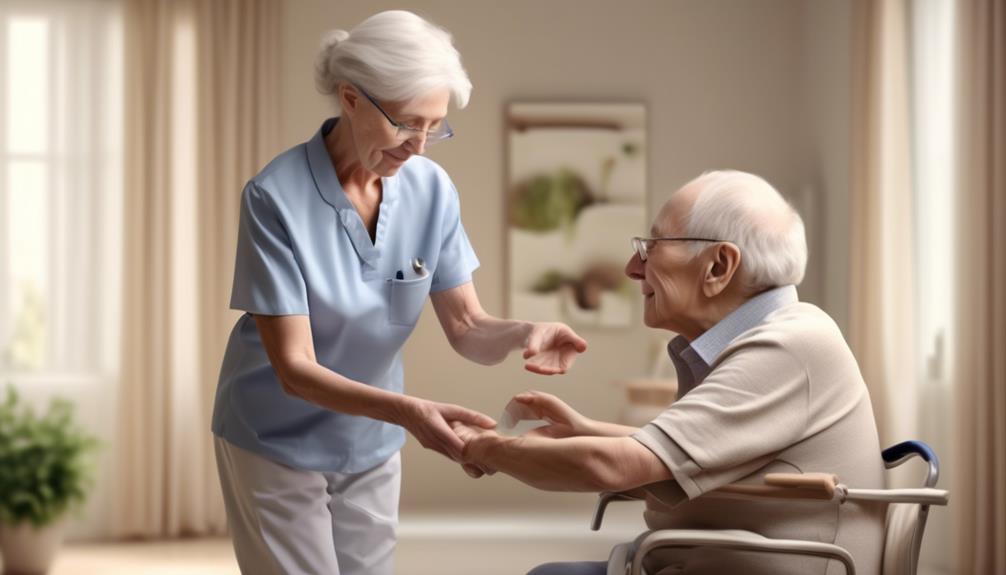Emphasizing the importance of safety and efficiency in physical activities involves prioritizing proper body mechanics and clear communication. While many individuals recognize the significance of lifting techniques and maintaining good posture, it’s also essential to acknowledge the role of communication in these situations, wouldn’t you agree?
Let's explore how effective communication can enhance our understanding of body mechanics and contribute to a safer work environment.
Key Takeaways
- Proper body mechanics enhance confidence and attentiveness in communication.
- Clear communication is vital for coordinating movements, especially in healthcare.
- Using nonverbal cues like eye contact fosters trust and rapport.
- Integrating body mechanics and communication promotes safety and collaboration in the workplace.
Importance of Proper Body Mechanics
Maintaining proper body mechanics is crucial for reducing the risk of injuries and promoting overall musculoskeletal health. In the realm of healthcare, emphasizing good body mechanics is essential to prevent work-related injuries and ensure the well-being of both patients and healthcare providers. By following techniques such as bending at the knees when lifting heavy objects and avoiding twisting at the waist, healthcare professionals can protect themselves from issues like back pain and muscle strains that may result from improper body mechanics.
Healthcare providers often face physically demanding tasks that require them to lift, transfer, or position patients. Using correct body mechanics not only decreases the likelihood of immediate injuries but also contributes to long-term musculoskeletal health. By incorporating proper body mechanics into daily practice, healthcare workers enhance their efficiency and safety when performing various physical duties, ultimately promoting a healthier work environment for all involved.
Prioritizing good body mechanics is a proactive approach to prevent musculoskeletal problems and maintain overall well-being in the healthcare setting.
Common Communication Barriers

In healthcare settings, effective communication is vital to ensuring quality care delivery, and one of the key aspects to consider is addressing common communication barriers. These barriers can hinder the exchange of information between healthcare professionals and patients, impacting the overall quality of care provided.
Some common communication barriers include:
- Language differences
- Cultural differences
- Distractions
- Emotional barriers
Misunderstandings often stem from poor listening skills, lack of feedback, misinterpretation of non-verbal cues, and conflicting information. Overcoming these barriers requires active listening, empathy, clear message delivery, and seeking feedback to ensure understanding. Additionally, being patient and asking clarifying questions can help minimize confusion and ensure all parties are on the same page. By practicing these communication strategies, individuals can improve interpersonal relationships and avoid common life mistakes that arise from miscommunication. This, in turn, fosters more productive and harmonious interactions in both personal and professional settings.
In healthcare, addressing communication barriers is crucial for accurate information exchange, patient comprehension, and ultimately, improving patient outcomes. By recognizing and actively working to overcome these barriers, healthcare professionals can enhance communication effectiveness and deliver better care to those they serve.
Techniques for Effective Communication
What're some effective techniques for enhancing communication in healthcare settings?
In healthcare, proper body mechanics and effective communication go hand in hand. Active listening, asking clarifying questions, and using nonverbal cues such as maintaining eye contact and nodding can show patients that you understand and care about their concerns. Being clear, concise, and respectful in your interactions fosters trust and understanding.
Open-ended questions encourage patients to share more information, helping healthcare providers make accurate assessments. Nonverbal communication, including body language and facial expressions, plays a crucial role in conveying empathy and building rapport. In healthcare settings, where patients may feel vulnerable, it's essential to communicate in a way that reassures and supports them.
How Body Mechanics Impact Communication

Proper body mechanics significantly impact communication effectiveness by promoting confidence and attentiveness through good posture and body alignment. Maintaining correct posture and alignment can enhance communication in various ways:
- Confidence Boost: Standing or sitting upright conveys confidence and assertiveness, positively influencing how others perceive your message.
- Active Listening: By aligning your body correctly, you demonstrate attentiveness and show respect to the speaker, fostering better communication.
- Physical Comfort: Proper body mechanics prevent discomfort or pain, allowing you to focus on the conversation without distractions.
- Non-verbal Communication: Your body language, influenced by good posture, can convey openness and engagement, aiding in effective communication.
Integrating Body Mechanics and Communication
Integrating body mechanics with effective communication skills enhances teamwork and safety in various professional settings. By maintaining a stable base of support and utilizing proper body mechanics, individuals can reduce the risk of injuries and strains during physical tasks. Clear communication is crucial for coordinating movements, especially in high-pressure environments like healthcare settings where teamwork is essential for patient care. Understanding how to position oneself correctly, distribute weight efficiently, and communicate intentions clearly can lead to smoother interactions and improved outcomes.
Incorporating communication techniques such as active listening, concise instructions, and feedback exchange into body mechanics training can further enhance the application of safe practices. Education and practice in both domains are key to fostering a culture of safety and collaboration in the workplace. Ultimately, the integration of body mechanics and communication not only benefits individual performance but also contributes to the overall success of team efforts in delivering quality care and services.
Frequently Asked Questions
What Are the 3 Important Concepts Related to Body Mechanics?
Three important concepts related to body mechanics are Center of Gravity (COG), Base of Support (BOS), and Vertical Line of Gravity.
COG represents the body's mass center, BOS is the area providing stability, and the Vertical Line of Gravity should align with COG for balance. Proper body alignment is crucial for good posture and injury prevention.
Understanding these principles helps us perform tasks safely, reducing the risk of musculoskeletal issues.
What Are 5 Reasons for Using Correct Body Mechanics?
Using proper body mechanics is essential for various reasons. It promotes safety, enhances efficiency, and reduces the risk of injuries.
Maintaining spine alignment, preventing chronic conditions, and decreasing joint pressure are all benefits of correct body mechanics. It's crucial to prioritize these practices in all physical tasks to ensure overall well-being and prevent accidents.
How Can You Ensure That You Are Using Proper Body Mechanics?
To ensure we're using proper body mechanics, we maintain a wide stance for stability, bend at the knees when lifting to protect our back, and align our neck, back, and hips for good posture.
Lifting with our knees, pushing instead of pulling, and engaging larger muscle groups help prevent injuries and strain.
What Is the Key to Proper Body Mechanics?
The key to proper body mechanics is maintaining alignment and using correct posture. By avoiding twisting at the waist and instead bending at the knees, we can protect our bodies from strain and injury.
It's crucial to lift with the knees, not the back, and keep a wide base of support with our feet. Aligning our neck, back, and hips while moving or bending helps us stay safe and prevent harm.
Conclusion
In the dance of workplace safety, proper body mechanics and effective communication are the partners that lead to a harmonious performance.
Just as a well-tuned orchestra relies on each musician playing their part, we must all understand how our movements and words impact our well-being.
By mastering these techniques and working in sync, we can create a symphony of safety and efficiency in our daily tasks.









